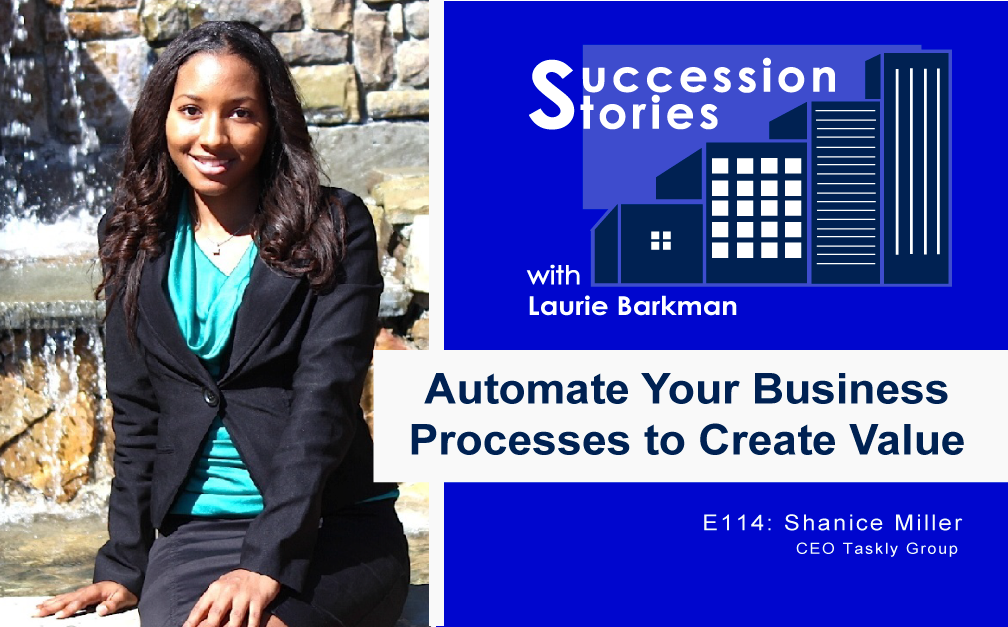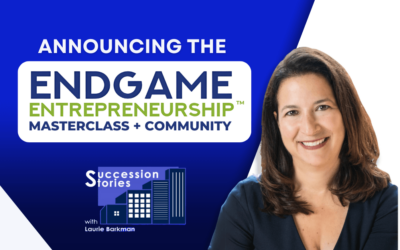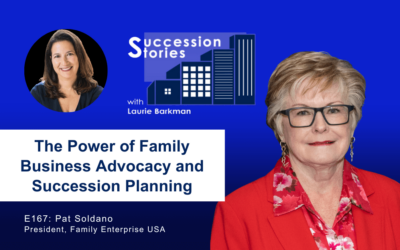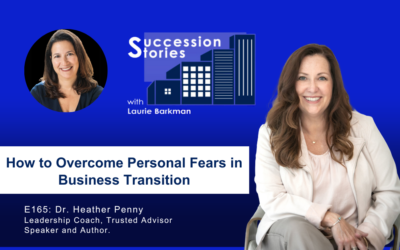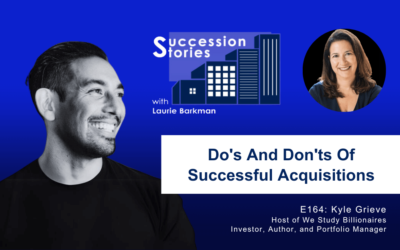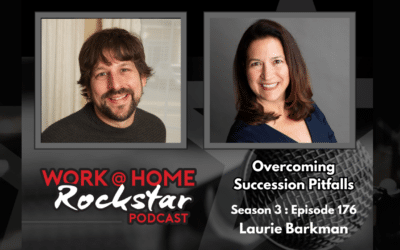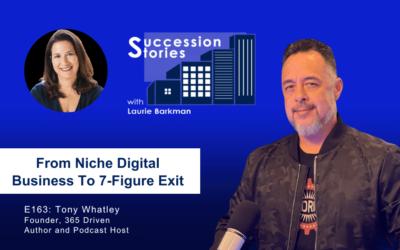Automation can free up hundreds of hours per individual employee every year. Better systems create operational efficiencies that make businesses more scalable. Shanice Miller is a business productivity consultant, specializing in project management, who helps clients ranging from small startups to multi-million dollar businesses save hundreds of hours and thousands of dollars. Over the last 10 years, Shanice has used her ability to identify operational inefficiencies and create solutions to not only help save her clients’ businesses (and hairlines), but to also fall in love with them again with simple, effective systems for hire.
Listen in to learn more about:
How the right systems can lead to faster, more valuable liquidity events
Avoiding burnout through more effective systems
- Mapping out the owner’s role in the marketing, sales, and client delivery systems
- Streamlining existing processes for productivity and efficiency
The value of process documentation
Show links:
https://tasklygroup.com/laurie
https://content.workmarket.com/2020-insight-report-what-ai-automation-mean-for-work/
Social links:
Connect with Shanice on LinkedIn: https://www.linkedin.com/in/shanicemiller/
Connect with Laurie on LinkedIn: https://www.linkedin.com/in/lauriebarkman/
Subscribe to the Succession Stories YouTube Channel
About Succession Stories Podcast
Succession Stories is an award-winning podcast guiding entrepreneurs from transition to transaction. From building value to letting go. The show received the 28th Annual Communicator Award for Audio & Podcast Excellence and is ranked in the top 2.5% of podcasts globally.
Join host Laurie Barkman, The Business Transition Sherpa, as she talks with entrepreneurs, family business leaders, investors, and industry experts as they explore the journey from business growth and innovation, creating a more valuable and transferable business, and avoiding succession regrets when exiting and selling your company.
If you are an entrepreneur looking for inspiration to create a more valuable business, or an owner who wants to figure out the best way to transition or sell their closely held company, this podcast is for you.
To learn more and subscribe to our newsletter, visit https://thebusinesstransitionsherpa.com
FEATURED SPONSOR: STONY HILL ADVISORS
Stony Hill Advisors works with owners like you to get ready and maximize value when you’re ready to sell.
Visit www.stonyhilladvisors.com/podcast for a complimentary business valuation.
Transcript
Intro:
Shanice Miller is a business productivity consultant, specializing in project management, who helps clients ranging from small startups to multi-million dollar businesses save hundreds of hours and thousands of dollars. Her passion for identifying and solving inefficiencies began when she sold her first business, an educational consultancy that had been recognized in Forbes and BET, at a less than premium price point because she didn’t have her systems and processes streamlined and documented. Over the last 10 years, Shanice has used her ability to identify operational inefficiencies and create solutions to not only help save her clients’ businesses (and hairlines), but to also fall in love with them again.
Laurie Barkman:
Shanice Miller, welcome to Succession Stories, this is going to be an interesting conversation because you have a great perspective on how entrepreneurs can build and scale their companies and this is a topic that I think hits every business from small to big, so welcome.
Shanice Miller:
Thank you so much, Laurie. I’m so excited to be here.
Laurie Barkman:
I’m glad Nana Bonsu introduced us. We can, why don’t we start by talking about your experience? How did you go from Project Manager at all different kinds of organizations, including the IRS to now becoming… you’re an entrepreneur, a successful entrepreneur?
Shanice Miller:
Yeah, so how I started off was, of course, trying to do the job thing. I always had just this entrepreneurial type, like, want and desire, burning inside of me, that wants so now I run a business operations firm, and it’s for business owners that have messy or no systems in place. What we do is we help make their daily activities more efficient, and we help their business to run suit smoother, so that they can maximize their impact and make sure that no clients slip through the cracks. As you know, I had that problem with sometimes clients slipping through the cracks, getting overwhelmed, especially in my first business, which was an educational consulting business.
I literally, it was one Friday evening, I was sitting at my desk, and I just finished all my work for the day, even though work is never done and I went to check my bank account, I opened up the books, and I just literally wanted to cry. Not because of the amount – that was supposed to be a really joyous time, because I was about to hit 8k for that week and that was my biggest week ever, but I was just so tired, I was doing everything; I was doing the Facebook ads, I was doing the sales calls the client work, I did not have any systems or processes in place, and I didn’t know to put any systems or processes in place, I had some business coaches that I used before in the past that tried to help me along the way with getting clients and that was very successful, but to actually put the systems in place so that you’re not getting burnt out. That was something that I saw was a gap in the marketplace. It wasn’t until I really felt that really like a pit in the bottom of my stomach of like, “I just want to give up this business,” I ended up selling it and because of that feeling that I really learned the power of systems and looking at other businesses, how they were selling, how they were doing their transitions, really combing through those businesses and seeing that, okay, all of these businesses that are getting really high price points that they are selling quickly, that it’s easy for the owner to transition out, it’s because they have the systems and processes in place, they have these SOPs so that a new owner could just jump right in, or even a new hire. If you’re trying to sell your business, a new hire can just jump right into where the other person left off, and not miss a beat without someone having to really give them that information. Tell them exactly what to do. I mean, I see that problem in so many businesses. It was in mind, so I just had that passion to want to just help other businesses do the same thing. We release some of that overwhelm.
Laurie Barkman:
Yeah, no, absolutely. We do want to prevent burnout. It’s not good for our health, it’s not good for the business, so that’s the number one thing I want to just to circle back on that you mentioned that you yourself felt that you had burned out, and you were ready to move on and we’ll jump back to Taskly Group here in a second. Tell us more about selling that company, how did you find a buyer?
Shanice Miller:
I put it on an online marketplace and I literally had to learn everything myself, so I’m going on there, I was trying to look at some other listings that were similar to mine, typing up what would what would people be interested in purchasing, listing all the information, going through their process of like documenting, that’s a process in its own, that I didn’t realize like absolutely, in order to really sell your business successfully with like a really good outcome, you have to be prepared for that too. Because like, by the time that I was overwhelmed, I just wanted it off of my hands in I mean, it really showed in the price point that I got but after I got that price point and after I saw that it was valued so low compared to what I was bringing in and all the value I had to bring with that business that’s when it started to turn things around. The wheel started clicking, and I realized, “Okay, it has to be more than just me doing all of the things, it has to have some kind of system in place so that I can transition this and have a really good outcome.”
Laurie Barkman:
Those are lessons learned the hard way.
Shanice Miller:
Yeah, absolutely.
Laurie Barkman:
I appreciate you sharing them. They’re key themes that we talk about on the show a lot and they are also key themes that I work on with clients, which is what makes a business more transferable, it needs to be attractive, and it needs to be ready, and it needs to be something that can be handed off. All of these different aspects are something that you’ve experienced personally. Let’s dive into the transferability part of this is, that’s a key part of what you’re saying is, if we want to have one day, a liquidity event, or we want to have a transfer, whether that transfers to management or a transfer to family, to a third party, what’s going to enable that transition to happen is a lot of things, right? There’s not just one thing so the thing that we’re talking about today is a key pillar, which is what are those key processes in the business that don’t have to be performed by the owner, or the founder, right, especially in a small company, if we’ve got a really small team, it’s exacerbated as you add more people, it can get even more exacerbated but it sounds like you work with a lot of–I don’t want to say solopreneurs–but people who are just starting out, but you also work with larger companies, so why don’t we talk about the work that you see why it’s so important to build scalable processes, and maybe share some examples of what those processes have been? How have you focused? How have you selected those key processes?
Shanice Miller:
Yeah, so I’ve actually worked with but I’ve also worked with six, seven and eight figure businesses and in those multimillion dollar companies, I saw that we could take a lot of those same processes and apply them to solopreneurs so that things can work quickly. What I realized was there was a trend. In every business, we have three key systems, we have your marketing systems, we have your sales systems, and we also have your client delivery systems. As you mentioned before, as an owner, you don’t necessarily have to be in any of these systems, or you can be in whichever system is your zone of genius. When I work with clients, I try to have the client really figure out what it is that they’d like doing, because it’s no point in running a business or having a business if you’re not doing what you love.
Some of the clients might say they want to focus on the marketing, and maybe hand off the client delivery or client services portion and the sales portion to someone else. Or someone else might say, “Oh, I really like working with clients so maybe I can hand over the marketing,” but we really work together to map out those processes, those three processes are really the lifeline in the pulse of your business. With one of my clients, they did web design services and with these three systems, they weren’t necessarily talking together so that she was losing out on a lot of business. She would have clients that would reach out to her in the DMS and Instagram, they would reach out via email, they would reach out via instant messenger, all of these different places that you’re getting clients, we had to work together to find out figure out how what would be the best way the best system that we could put in place so that all those clients go to one area so that they can get some automatic messaging, telling them where to go, where to sign up so that they can get set up for that sales call and then working them down the system.
We really work together to map out the full customer journey across those three, so that we can intertwine them together. Say if you’re getting leads in because you’re doing certain marketing tactics, and we’re looking at which ones are the most beneficial marketing tactics, and then those leads are crossing over into the sales department so that we’re closing on the sales, we’re sending out proposals, what would happen is some of those leads that were coming in, she would either forget to respond back, because they’re all over the place, or she will respond back slowly and when you do that, that’s when potential clients will go someone somewhere else. The other thing that I saw when we were working together was that after getting some of those leads, getting them on the phone, doing the sales calls, sometimes she would forget to send the proposals. That was $6,000 per person that she was missing out on just simply from forgetting to send the proposal or to not send the proposal in a timely fashion so those were systems that you can put in place that you can make a template so that you can make it a lot easier or you can automate it. We talked about, “Okay, how can we automate these systems? These same steps that you’re doing day in and day out?” And it’s not about recreating the wheel or reinventing the wheel. We’re using what she already tells us she’s doing and we’re streamlining it.
Laurie Barkman:
What part of this process do you think is about documentation and systems versus delegation?
Shanice Miller:
Oh, that’s a really good question. I think in order to successfully delegate, you have to document; so I actually had just this really quick instance, one person told me that they were having a problem with hiring so I said, “Okay, what, what are you finding that’s happening when you’re hiring?” And the guy told me, “You know, they’re not doing anything,” and I said, “Okay, so what do you mean, the person’s not doing anything? Are you giving them tasks to do, and they’re not doing them,” and he’s just like, “Well, the person just did nothing,” so as I’m digging deeper into the conversation, I’m seeing that the person–and sometimes I was at fault with this, too, with my own VA–I’m thinking of something very general that I can give the person to do to help me out so when I get my first VA, I was like, “Oh, maybe they can manage my inbox,” and that’s so general, like, how is someone going to manage your inbox? What are they going to say? How do they respond back to the emails? These are all things that are just in your head? That you really have to get down on paper? What is it that you’re doing? How are you thinking these things through so that you can pass it on? You can have that same high level quality of work that each of your clients can experience?
When I was working with the other guy, and he’s telling me, “No one’s working out,” I said, “Okay, well, what kind of assignments? Would you hire the person to do a little bit of this, a little bit of that? A little bit of this little bit of that?” I see so many people will just want someone to take over and do everything but we have to really get clear on what is it we’re hiring this person to do? What are the main tasks that we want them to do? How do we want them to do it, and at least giving them a little bit of guidance or some baselines to go around, it will help them so that maybe they can give you some feedback on those processes afterwards, but at least give them something to go with.
It’s the same as I know, I got some furniture one time, and it all came unassembled so I’m getting all these pieces, 30 screws, 50 bolts, all these little pieces in all it had what was the outcome picture and I was like, “Where are the instructions?” and that’s exactly how your new hires feel. You’re giving them all this stuff besides just like generic instructions, all the pieces, if you’re telling them, “Take over your inbox,” you’re just giving them the emails, but you’re not really giving them instructions of how to put this together, how to make the furniture and I know that when I’m going through that process of trying to put together some furniture without really having directions, I’m guessing I’m not using all of the screws that came in the box. It’s coming out and falling apart as I’m trying to put it together is so frustrating and you can just bypass all of it by doing that documentation so that you can prepare for hiring someone that way you’re clear on what that person should be doing. That person is clear on what they should be doing as well without you having to sit there and hold their hand the entire time and you’re going to get that same level of quality in the product that you produce, after having that person to do the same steps that you’re telling them to.
Laurie Barkman:
Yeah, absolutely. It can be a virtual assistant. We referenced VA, I just want to make sure the audience knows virtual assistant roles and what that generally means is that you’ve got someone part time working for you, but they’re also serving a lot of other clients and you can give them specific roles to help them take some things off your plate and you’ve just shared some great examples, Shanice of what that looks like. I do want to also come back to the concept of how creating processes that enable you to scale can create value. There was an interview I did on the show, episode 54, so if the audience wants to go find that episode, I think it’s a great example. Just to underscore what we’re saying, Kevin Urrutia and Kevin and his brother had a service business, they built a service company, a cleaning company and residential cleaning services and their mission was to document all the processes that they could top to bottom and that was one of the reasons that they were able–he credits that their ability to sell the business at a multiple that they were targeting and so listeners might be thinking, “Well how do I connect the dots on this? Why is documenting processes so important?” What would you say to that, along this theme of how does having a perspective on your processes and delegation help create value as you’ve seen?
Shanice Miller:
I’ve seen them help create value, because it’s helping you to let someone step into your shoes, anywhere in the process at any time. Some of the times what I would do for certain clients is we use a project management software, and it can be any, I am not a really big stickler on a tool, I do have my preferences but whenever we’re using that project management tool, and really mapping out a process, I do process mapping in my three step framework, where we’re going through and we’re saying, “Okay, what’s step one, what’s step two, what’s step three,” all the way to however you can complete the process and having that software to make sure that the person is either checking off all of those steps in the process, or moving it down the line, so that we’re making sure we’re not skipping any steps and then what happens in businesses, an employee might call out the day. Or if they decide to up and quit, you know that this employee was at this place in the process and I can just insert someone else with that same job title and tell them this is where they left off, this is what we did before, this is what we did after, but they can see all of that in the project management system and that’s how it makes it easy to scale. It makes it easy to take one person in from one project and put them into the other and it also makes it easy when, like you talked about, with transitioning and I’m sure your program talks about that transition process too which is what I wish I had when I was going to sell my business.
Laurie Barkman:
It’s very important for the transferability, as we mentioned, and also because what we’re doing is we’re inherently managing our risks, we’re trying to minimize risks so it’s operational risk, if you have a key person, whether it’s you or it’s someone else, who leaves the organization and takes that know-how with them and takes that process with them and of course, when you’re looking to have a liquidity event or sell, and then transition the business to a third party these are the questions they’re asking. They’re asking, of course, about the sales process and that was one of the three main areas you talked about, Shanice. For sales, I had a client who was the main person. He’s the Rainmaker and what we did was we worked on creating and documenting an actual process. He didn’t realize that’s what he was doing, we had to sort of formalize that so I love that’s where you start with people on those three pillars, those three systems of marketing, sales and client delivery. Of course, there are other systems and we could talk all day about those, right, whether they’re financial and accounting, and so on, and so on. Because I think, How can business owners really identify, maybe it’s things that they don’t enjoy doing and they just need to get off their plate, or they’re things that they are just not good at, and they don’t want to learn and they don’t want to become good at those and they can delegate those to someone internally or someone externally so you yourself become process as a service in a way right where you are for hire that they can, they can reach out to you and say, “I really want to do better at this, but it’s feels overwhelming,” and I know you’re available for clients to reach out to you, what’s the best way for them to find you?
Shanice Miller:
Yeah, so all your clients can go to my website. I have a special page just for you tasklygroup.com/laurie and that’s where they can book a call with me if they know that they need some help in setting up and automating their systems and processes or even starting them. Like you said, a lot of people have it in their minds and we need to really get it down on paper and in the software so other people can follow. In that same website, tasklygroup.com/laurie, they can get my three steps to automate systems in your business so you can scale to six, seven and eight figures.
Laurie Barkman:
That’s awesome so let’s wrap up with some final words of wisdom from your experience for business owners, what would be the three things you want them to remember?
Shanice Miller:
Oh, I want you to remember to document and delegate and also my three step framework is define, design and do, so first define exactly what it is that you want to document what it is you want to delegate, then design design the steps actually map out those steps of what it is that that person needs to do in order to have that end goal accomplished successfully and then to do actually implement it to put it into a software so someone else can be plugged in played into those same steps.
Laurie Barkman:
Awesome. Do you have any favorite quotes that inspire you as an entrepreneur?
Shanice Miller:
Yes. One of my favorite quotes is I have not failed, I’ve just found 10,000 ways that won’t work. Because we all know that in entrepreneurship, we’re trying different things and the person who doesn’t fail, the person who remains consistent and persistent is the person who wins. Because either if it’s in sales tactics, and how you’re selling and closing calls, you might be failing in that aspect until you’re building up that muscle and you’re learning what works and what doesn’t work or in your marketing, maybe you’re trying some techniques with podcasting or with ads, and you could be failing at certain ads but if you keep tweaking and evaluating to see what works, then you will find something that eventually works in the same with your products. If you’re selling something, and it’s not quite hitting right, or what you’re saying isn’t really aligning with what everyone is needing, you’re going to keep failing, in a sense at those things until you find exactly what works and then that is how you have not failed.
Laurie Barkman:
Absolutely. You’ve been smiling probably 80% of the time on the video, so anyone watching on YouTube is going to see that because I was going to ask you what energizes you the most about your work so nice, but it’s obvious. what energizes you; you’re looking to make businesses more valuable and helping business owners run a more enjoyable company, so I want to thank you for being with me today, and sharing your experience.
Shanice Miller:
Thank you so much for having me, Laurie, I really appreciate it.
Laurie Barkman:
Listeners, thank you so much for your support. Catch Succession Stories on your favorite podcast player or YouTube, and subscribe to the show! If you want to maximize the value of your business and plan for future transition, reach out to me for a complimentary assessment at meetlauriebarkman.com. Join me next time for more insights from transition to transaction. Until then…here’s to your success.

